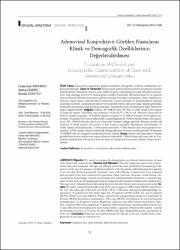| dc.contributor.author | Kantarcı, Feride Aylin | |
| dc.contributor.author | Demirci, Göktuğ | |
| dc.contributor.author | Özsütçü, Mustafa | |
| dc.date.accessioned | 2020-07-21T09:59:21Z | |
| dc.date.available | 2020-07-21T09:59:21Z | |
| dc.date.issued | 2017 | en_US |
| dc.identifier.citation | Kantarcı, F. A., Demirci, G. ve Özsütçü, M. (2017). Adenoviral konjonktivit görülen hastaların klinik ve demografik özelliklerinin değerlendirilmesi. Türkiye Klinikleri Oftalmoloji Dergisi, 26(2), 71-76. https://dx.doi.org/10.5336/ophthal.2016-51339 | en_US |
| dc.identifier.issn | 1300-0365 | |
| dc.identifier.issn | 2146-9008 | |
| dc.identifier.uri | https://dx.doi.org/10.5336/ophthal.2016-51339 | |
| dc.identifier.uri | https://hdl.handle.net/20.500.12511/5587 | |
| dc.description.abstract | Amaç: Adenoviral konjonktivit görülen hastaların demografik ve klinik özelliklerinin de- ğerlendirilmesidir. Gereç ve Yöntemler: Klinik olarak adenoviral konjonktivit tanımlanan hastalar değerlendirildi. Hastaların cinsiyeti, yaşı, etkilenen gözü, yakınlarında aynı göz belirtileri olan kişilerin olup olmadığı, havuz veya denize girme öyküleri kaydedildi. Biyomikroskopi ile ön segment muayenelerinde foliküler konjonktivit görülen hastalar konjonktiva hiperemisi, siliyer enjeksiyonu, kemozis, kapak ödemi, subkonjonktiva hemorajisi, kornea tutulumu ve psödomembran oluşumu açısından incelendi. Çalışmamızda adenoviral konjonktivitlerin daha çok hangi yaşlarda görüldüğü, bulaşıcılık durumunun olup olmadığı araştırıldı. Hastalarda kornea tutulumunun diğer faktörlerle ilişkisi değerlendirildi. Bulgular: Çalışma, 28 (%38,9) kadın, 44 (%61,1) erkek olmak üzere toplam 72 hasta ile yapıldı. Hastaların yaş ortalaması 19,35±15,27 (1-58) yıl idi. Muayene esnasında 16 (%22,2) hastanın sağ gözü, 15 (%20,9) hastanın sol gözü ve 41 (%56,9) hastanın her iki gözü etkilenmişti. Konjonktivitin ortaya çıkma şekli sorgulandığında 22 (%30,6) hastada bulaş yolu saptanmadı. Elli (%69,4) hastada yakın çevre kaynaklı bulaşma olduğu görüldü. Bulaşma görülen 50 hastadan 21 (%42) hastaya aile içinden, 3 (%6) hastaya yaşadıkları apartmanın sakinlerinden, 17 (%34) hastaya arkadaşlarından, 3 (%6) hastaya denizden, 4 (%8) hastaya daha önce gittikleri hastaneden, 2 (%4) hastaya kreşten bulaşıcılık olduğu öğrenildi. Korneal tutulum görülen 16 hastanın 11 (%68,8)'inde her iki gözde subepitelyal keratit izlendi. Sonuç: Adenoviral konjonktivit, kişinin günlük faaliyetlerini etkileyerek yaşam kalitesini düşürebilir. Yüksek bulaşıcılık oranı olan bu konjonktivit tipinde hem klinisyenin hem de hastanın bulaşıcılık konusunda dikkatli olması önerilmelidir. | en_US |
| dc.description.abstract | Objective: We aimed to evaluate the demographic and clinical characteristics of cases with adenoviral conjunctivitis. Material and Methods: Clinically diagnosed adenoviral conjunctivitis cases were evaluated. The age, sex, affected eye of the cases, the history of swimming in the pool or in the sea, the presence of affected relatives with the similar ophthalmological symptoms were recorded. Biomicroscopically examined cases with follicular conjunctivitis were evaluated and recorded if they had conjunctival hyperemia, ciliary injection, chemosis, eyelid edema, subconjunctival hemorrhage, corneal involvement and pseudomembran formation in anterior segment. In this study we investigated prevelance of age and infectiousness of adenoviral conjunctivitis. The cases were evaluated about relationship between the other factors and corneal involvement. Results: The study was performed with a total of 72 cases composed of 28 women (38.9%) and 44 men (61.1%). The mean age of the cases was 19.35 ± 15.27 (1-58) years. During the ophthalmologic examination, 16 patients (22.2%) of the right eye, 15 patients (20.9%) of left eye, and 41 patients (56.9%) of both eyes were affected. When conjunctivitis contagiousness situation is examined, in 22 cases (30.6%) showed no contamination. Fifty cases (69.4%) were found to be of environmental contamination. In 21 patients within 50 patients infection seen (42%) spread from family members, 3 patients (6%) from neighbours, 17 patients (34%) from friends, 3 patients (6%) from the sea, 4 cases (8%) from the hospital they have visited before, 2 patients (4%) from the nursery. Corneal involvement was seen in 11 of the 16 cases (68.8%) who had subepithelial keratic precipitates in both eyes. Conclusion: Clinicians and patients should be advised to be very careful about contagiousness in this type of conjunctivitis. | en_US |
| dc.language.iso | tur | en_US |
| dc.rights | info:eu-repo/semantics/openAccess | en_US |
| dc.subject | Konjonktivit | en_US |
| dc.subject | Viral | en_US |
| dc.subject | Keratit | en_US |
| dc.subject | Adenovirüs Enfeksiyonları | en_US |
| dc.subject | Conjunctivitis | en_US |
| dc.subject | Viral | en_US |
| dc.subject | Keratitis | en_US |
| dc.subject | Adenoviridae Infections | en_US |
| dc.title | Adenoviral konjonktivit görülen hastaların klinik ve demografik özelliklerinin değerlendirilmesi | en_US |
| dc.title.alternative | Evulation of clinical and demographic characteristics of cases with adenoviral conjunctivitis | en_US |
| dc.type | article | en_US |
| dc.relation.ispartof | Türkiye Klinikleri Oftalmoloji Dergisi | en_US |
| dc.department | İstanbul Medipol Üniversitesi, Tıp Fakültesi, Cerrahi Tıp Bilimleri Bölümü, Göz Hastalıkları Ana Bilim Dalı | en_US |
| dc.authorid | 0000-0002-5079-4713 | en_US |
| dc.authorid | 0000-0001-8954-5055 | en_US |
| dc.identifier.volume | 26 | en_US |
| dc.identifier.issue | 2 | en_US |
| dc.identifier.startpage | 71 | en_US |
| dc.identifier.endpage | 76 | en_US |
| dc.relation.publicationcategory | Makale - Ulusal Hakemli Dergi - Kurum Öğretim Elemanı | en_US |
| dc.identifier.doi | 10.5336/ophthal.2016-51339 | en_US |


















